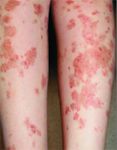Cayenne pepper boy
You are asked to evaluate a healthy 14-year-old boy who is peppered with asymptomatic golden brown spots. What's the diagnosis and how would you manage him?

Diagnosis: Progressive Pigmentary Dermatosis
Progressive pigmentary dermatosis (PPD) is a chronic skin disease characterized by petechial hemorrhage thought to be secondary to capillaritis. Lesions are classically diffuse, irregular, symmetric, discrete, red-brown 1- to 2-mm petechiae ("cayenne pepper" spots) that may fuse to form large confluent patches.1-3 However, unilateral and localized patches have also been described. Lesions are asymptomatic and usually affect the lower legs, but they can spread to the thighs, arms, and trunk. There are no consistently reported systemic or laboratory findings.
Etiology
Medical workup usually fails to identify an etiologic factor. In one case series, approximately 25% of chronic pigmented purpura cases had a possible identifiable trigger including drug hypersensitivity, stasis dermatitis, or contact dermatitis. Some authors suggest pigmented purpuric dermatosis may represent a reaction to remote bacterial infections, such as tinea pedis and dental infections. Others believe delayed-type hypersensitivity or immune-complex vasculitis plays a role in the disorder.1-3
Course
PPD can begin in childhood, but it is most commonly found on the lower legs of young adult men. Although most cases tend to be chronic, with periods of improvement and worsening, the lesions occasionally fade after months to years. In a case series of 13 children, eight cases persisted (one to seven years later), four patients had fading of lesions after one to four years, and one patient had lesions resolve after six years. Laboratory studies were normal in all patients.1
Differential diagnosis
Early in the course of the eruption, the lack of systemic complaints should help to distinguish PPD from meningococcemia, rickettsial infections, and other infectious vasculitis. Both infectious leukocytoclastic vasculitis and Henoch-Schönlein purpura present with palpable purpura rather than the macules typical of PPD. Bleeding disorders can be excluded quickly with a normal complete blood count and coagulation studies. The chronic course and characteristic color of PPD lesions in most patients is clinically diagnostic. Finally, dermatopathology findings can be used to confirm the diagnosis and exclude other causes of purpura.
Treatment
Although the eruption is asymptomatic, no treatment has proven to be consistently effective. However, case reports have demonstrated improvement with a number of different therapies including topical steroids, oral griseofulvin (Fulvicin U/F, Grifulvin V, others), oral pentoxifylline (Pentoxil, Trental), and photochemotherapy (PUVA).3 Adolescents and young adults with widespread disfiguring lesions should be counseled about the innocent nature of PPD, and measures should be taken to camouflage them.
More on our patient
Although we initially planned to treat him with PUVA, his lesions became more subtle over the subsequent four months, and treatment was deferred.
Please see Dr. Cohen's Web site, http://www.dermatlas.org/, for additional images
References:
1. Torrelo A, Requena C, Mediero IG, et al: Schamberg's purpura in children: A review of 13 cases. J Am Acad Dermatol 2003;48:31
2. Dessoukey MW, Abdel-Dayem H, Omar MF, et al: Pigmented purpuric dermatosis and hepatitis profile: A report on 10 patients. Int J Dermatol 2005;44:486
3. Bolognia JL, Jorizzo JL, Rapini RP: Purpura and Coagulation. In: Dermatology, Vol. 1, pp. 361-362